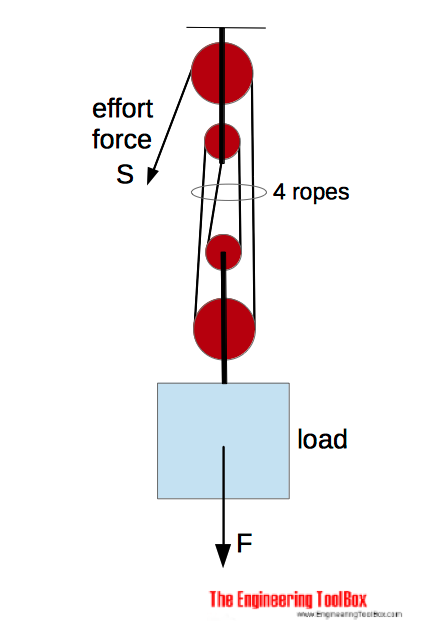Pulleys
Pulleys, blocks and tackles.
A pulley is a device that can increase the magnitude of an effort force.
Without Pulley

With no pulley - the effort force is similar to the load - in opposite direction.
S = F (1)
where
S = effort force (N, lb)
F = load (N, lb)
Single Pulley
Fixed Pulley

With a single fixed pulley the effort force is similar (or more due to efficiency loss) to the load.
S = F (2)
The advantage with the single fixed pulley is that the direction of force is changed - it is possible to pull down instead of lifting up.
Movable Pulley

With a single moveable pulley the effort force is half (or more due to efficiency loss) of the load.
S = 1/2 F (3)
Combined Pulleys

With a combined moveable pulley as above - the effort force is half (or more due to efficiency loss) of the load.
S = 1/2 F (4)

With two pulleys and the ropes as above - the effort force is 1/3 (or more due to efficiency) of the load.
S = 1/3 F (5)
General Equation for Blocks and Tackles
The general effort force equation for a block or tackle to raise or pull a load can be expressed as
S = F / (μ n)
= (m g) / (μ n) (6)
where
S = effort force (N, lb)
F = load (often weight) (N, lb)
m = mass (kg, slugs) (when lifting a mass)
g = constant of gravitation (9.81 m/s2, 32.17405 ft/s2) (when lifting a mass)
μ = mechanical efficiency of the system (equal to one for an ideal friction-less system, a fraction less than one for real-world systems with energy losses due to friction)
n = number of ropes between the sets of pulleys
Block, Tackle or Pulley Calculator
The calculator below can be used to calculate effort force in block, tackle or pulley construction. The calculator can be used for metric and imperial units as long as the use of units are consistent.
Note that kg is the SI units for mass - more about mass and weight !
Example - Pulley and Effort Force

The effort force for a pulley with 4 ropes , friction loss μ = 0.8, and load 100 kg can be calculated as
S = (100 kg) (9.81 m/s2) / ((0.8) (4))
= 307 N



